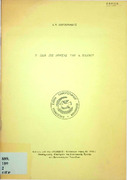Please use this identifier to cite or link to this item:
https://dspace.larlib.gr/handle/123456789/1637| Title: | Η Ωδή εις Μούσας του Α. Κάλβου. Πηγές και Επιδράσεις |
| Authors: | Περυσινάκης, Ι. Ν. |
| Keywords: | Κάλβος Ανδρέας -- Νεοελληνική ποίηση -- Ερμηνεία και κριτική | Νεοελληνική λογοτεχνία |
| Issue Date: | 1985 |
| Abstract: | SUMΜARΥ The author's intention is to trace probable sources of Kalvos’ ode “Eis Mousas” from ancient Greek Literature and Thought, to examine their meaning and see how they are re-formed and to seek the ode’s meaning through these models. The invocalion of the Muses, used in its original function, the cosmic dimension of the Muses (as e.g. in Alcman), the harmony of the spheres, the lyre, Orpheus, Dionysus. Apollo, and what they stand for, and the “Gegeneis”, are themes which are found in the ode and exploited in a way showing the poet's familiarity with the ancient Greek literary tradition. Some further similarities in phraseology between Kalvos and Pindar are also indicated. The author points out that the poet did not have a merely superficial knowledge of Greek Literature nor did he use it in a purely decorative way, as is sometimes suggested, but that he had a close acquaintance with it. His sources and themes are fully remodelled in their new context and serve the poet's inspiration and purpose. The author also argues that Kalvos knows and applies lo this ode the structure of the cletic and Homeric hymn. This approach gives a new meaning to the ode and shows its strict unity. Kalvos must have had a direct knowledge of ancient Greek language and Literature; but in his classicism he was also influenced by Foscolo. In an appendix to this study the author argues for the influence of Foscolo's “Grazie” on Kalvos “Eis Mousas” and examines the parallel passages and motifs in the two poems. |
| Description: | Σκοπός αυτού του άρθρου είναι να εντοπίσει τα πιθανά πρότυπα της ωδής Εις Μούσας από την αρχαία ελληνική λογοτεχνία και μυθολογία, να ερευνήσει τη σημασία τους, να εξετάσει πώς μεταπλάθονται στην ωδή, και τέλος να δώσει τη «σημαντική» της ωδής μέσα από τα πρότυπα αυτά. Δε θα πρέπει να ξεχνάμε ότι η ωδή είναι ένας ύμνος στις Μούσες. Επομένως ό,τι λέγεται στην ωδή αναφέρεται έμμεσα ή άμεσα στις Μούσες, όχι τόσο ως τις εννέα συγκεκριμένες θεότητες, αλλά κυρίως σε ό,τι εκείνες συμβολίζουν. Έτσι υπάρχει αρχικά η επίκληση προς τις Μούσες (κυριολεκτικά, επίκληση προς τις Χάριτες), η συμπαντική διάσταση των Μουσών και το θέμα της αρμονίας των σφαιρών. Ακολουθούν οι δραστηριότητες των Μουσών, καθώς και η σχέση τους με τον Ορφέα, το Διόνυσο και τον Απόλλωνα μέσα από την ευεργετική επίδρασή τους προς τους ανθρώπους. |
| URI: | https://dspace.larlib.gr/handle/123456789/1637 |
| Appears in Collections: | ΑΝΑΤΥΠΑ |
Files in This Item:
| File | Description | Size | Format | |
|---|---|---|---|---|
| Η Ωδή εις Μούσας του Α. Κάλβου.pdf Until 2099-01-01 | 1.35 MB | Adobe PDF |  View/Open Request a copy |
Items in DSpace are protected by copyright, with all rights reserved, unless otherwise indicated.


